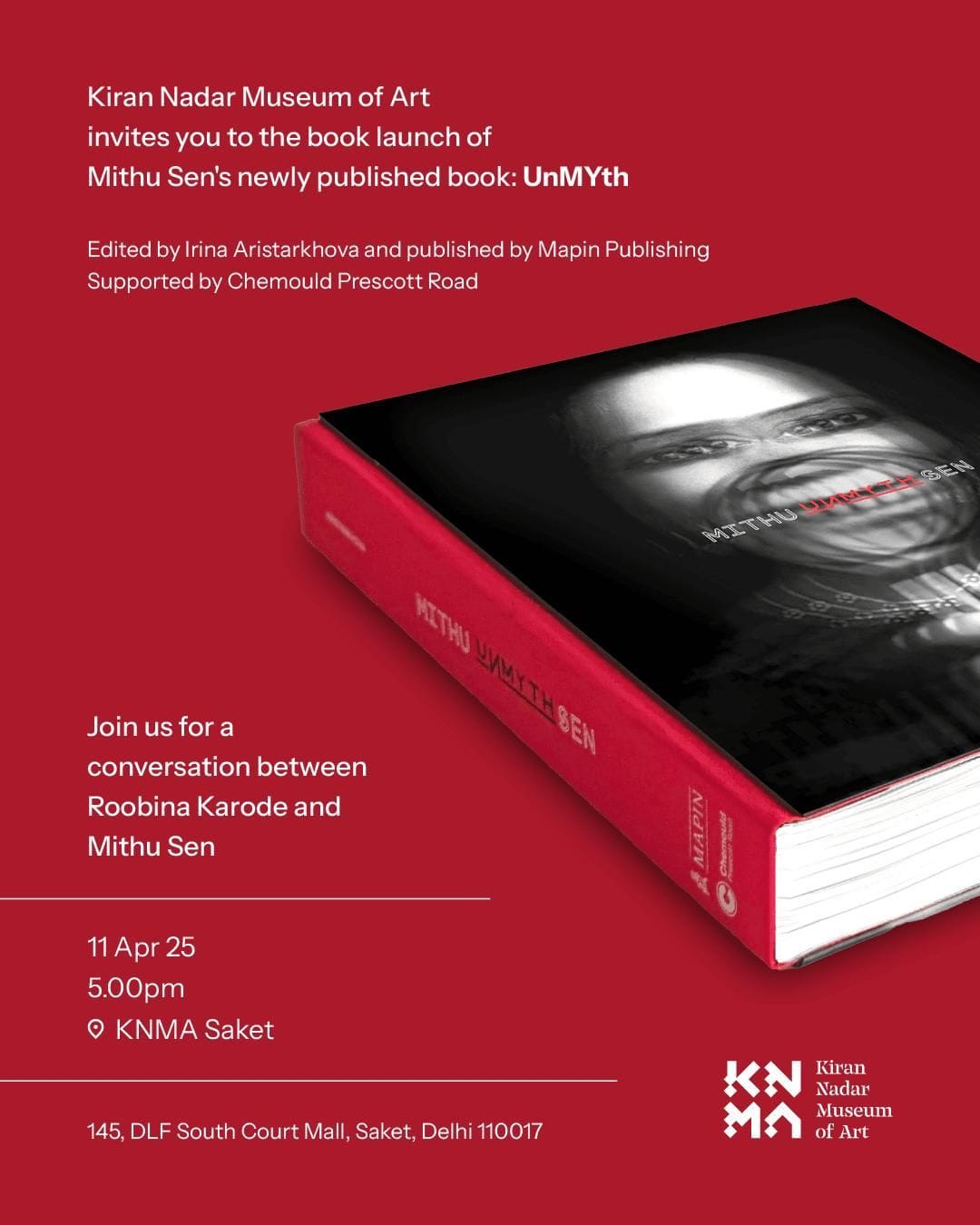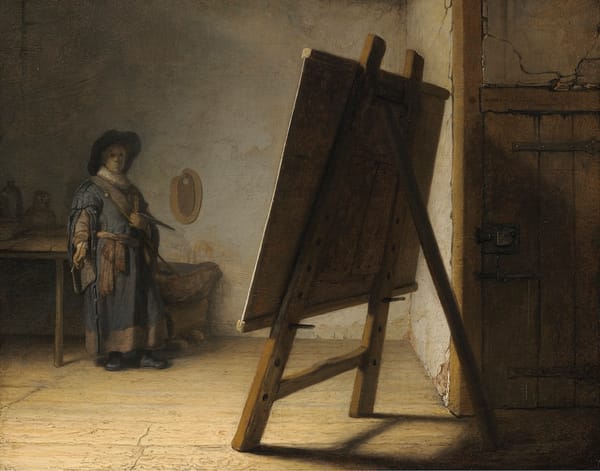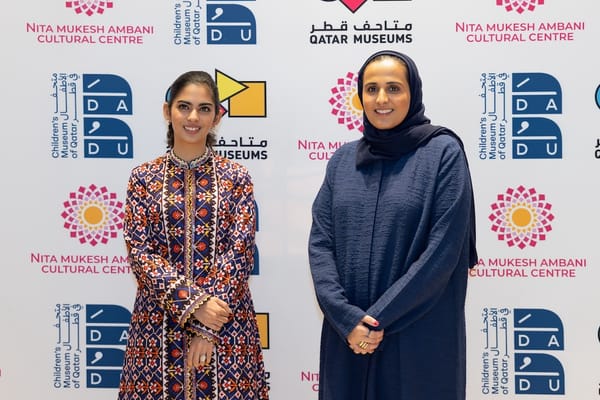Lingual Anarchy and Radical Hospitality: In Conversation with Mithu Sen
Through lingual anarchy and radical hospitality, Mithu Sen dismantles the fixed codes of identity and artistic persona, drawing audiences into a raw, visceral space where power, performance, and meaning are always in flux.
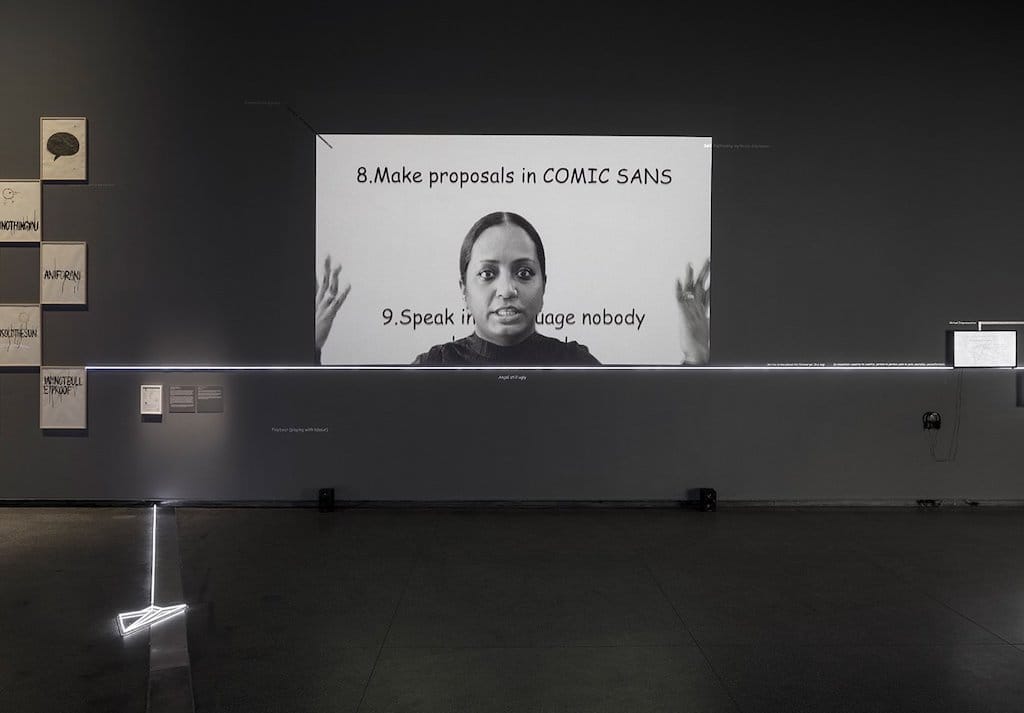
Mithu Sen is a provocateur of form and thought, whose multidisciplinary practice spans drawing, performance, poetry, video, sound, sculpture, and installation. Born in West Bengal in 1971, Sen has developed a uniquely disruptive voice that probes the myths surrounding sexuality, language, capitalism, and marginalisation. Her work unsettles hierarchies—those embedded in systems of art, identity, and global exchange—through a conceptual framework she calls “lingual anarchy,” a space of intentional un-language and sonic improvisation. Whether confronting tropes of exoticism or exposing the coded expectations around artistic persona, Sen persistently destabilizes comfort zones. In this interview, she reflects on the politics of visibility, audience reception across geographies, and the performative tension between artist, identity, and institutional gaze.
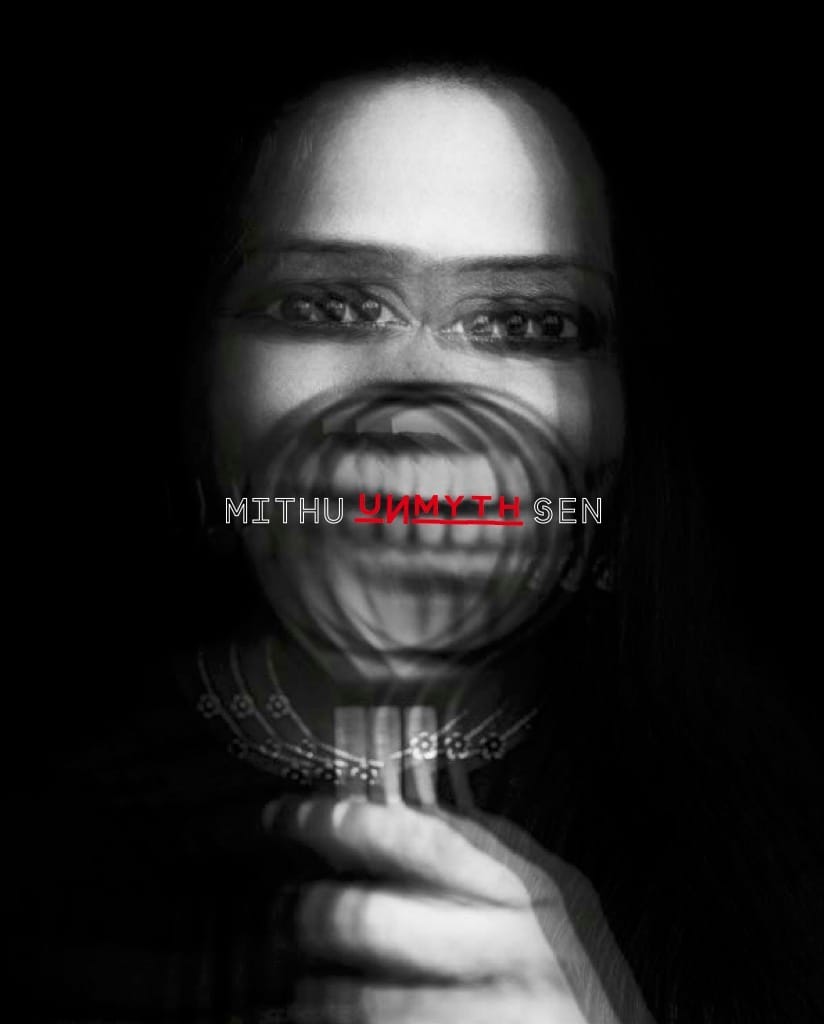
Nikhil Sardana: Your new monograph, UnMyth, presents a comprehensive study of your work, bringing together perspectives from scholars, curators, and critics. How did this project come about, and what was the experience of seeing your practice analysed through so many lenses?
Mithu Sen: The making of UnMyth has been an unfolding of many selves. At the heart of the book is a fictional interview in which I fragment into five or six personas—some mythic, some absurd, some mischievous—interviewed by both fictional and non-fictional characters. This mode of multiplicity was inspired by the heteronymous identity of Fernando Pessoa, who wrote through a chorus of alter egos. For me, this was not merely a literary device, but a philosophical gesture: to dissolve the idea of a fixed identity.
Through this lens, the book becomes a terrain of discovery. Seeing my practice filtered through five distinct voices—writers, scholars, critics—was like witnessing a séance of selves. I encountered unknown corners of myself, refracted through their interpretations. And I know there will be more revelations when the book finally lands in the world.
My practice—especially in the digital and networked space—is an attempt to rewrite how the artist’s identity is represented and consumed. I act as a kind of aesthetic disclaimer, an anarchist whispering through the system. I use seduction and subversion to destabilize monolithic constructs of selfhood, authorship, and recognition.
This book also touches on the irony of international visibility—how it often demands the performance of exotic suffering or postcolonial trauma. As a woman from the Global South, I am aware of the double-edged demand for cultural specificity, and how it can teeter into stereotype. The female body becomes cult, the narrative becomes pity. This monograph doesn’t try to resolve that conflict—it plays with it, resists it, reveals it as a pedagogy of satire, caught within the neoliberal and patriarchal structures of art and academia.
In making UnMyth, I allowed myself to be consciously fragmented. But through dialogue with deeply thoughtful contributors, I began threading those shards together—not into a neat chronology, but into a conceptual constellation. It’s still scattered. But it’s also a way of life.
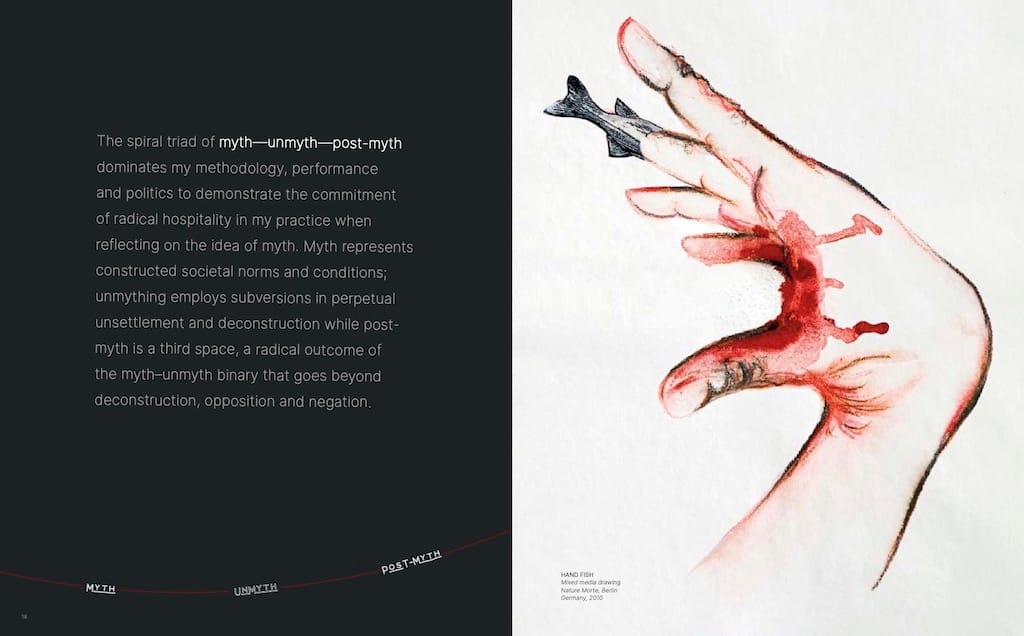
NS: In the book, you engage with concepts like ‘mything,’ ‘unmything,’ and ‘postmything,’ as well as radical hospitality and lingual anarchy. Can you share how these ideas have evolved in your work and how you see them shaping contemporary art discourse?
MS: UnMyth unfolds across three fluid states: Myth – UnMyth – PostMyth. It begins by unravelling inherited cultural, social, and political myths—not to replace them with new truths, but to destabilize meaning altogether. UnMyth is not denial, but unlearning—a conscious undoing.
PostMyth is the residue—a quantum space, indeterminate and hovering just beyond language. Not a conclusion, but an afterlife of meaning. My practice lives in this space of perpetual unsettlement, of becoming. I work through the medium of “Un”—undoing, unmaking, unsaying—with vulnerability, humour, and intuition.
Here, lingual anarchy enters. I disrupt institutional language and grammar through playbour (play + labour), as both critique and joke—resisting the productivity mandate of the neoliberal art world. Challenging authority becomes a method of radical openness, creating space for play, disruption, and infinite interpretation.
It’s no longer just about deconstruction, but questioning whether new myths need to be built at all. Radical hospitality grounds my practice—rethinking the guest/host dynamic, especially in a world that tolerates rather than embraces difference.
I navigate the layered terrains of the art world through affirmative sabotage—where performance becomes an encounter, a rupture, a discomfort that provokes.
Ultimately, I am drawn to that desperate search—the one that lies beyond the myth, the unmyth, even the postmyth. All roads, for me, lead to the same place: the ARTRUST and the search for self. The discourse, as always, arrives later.
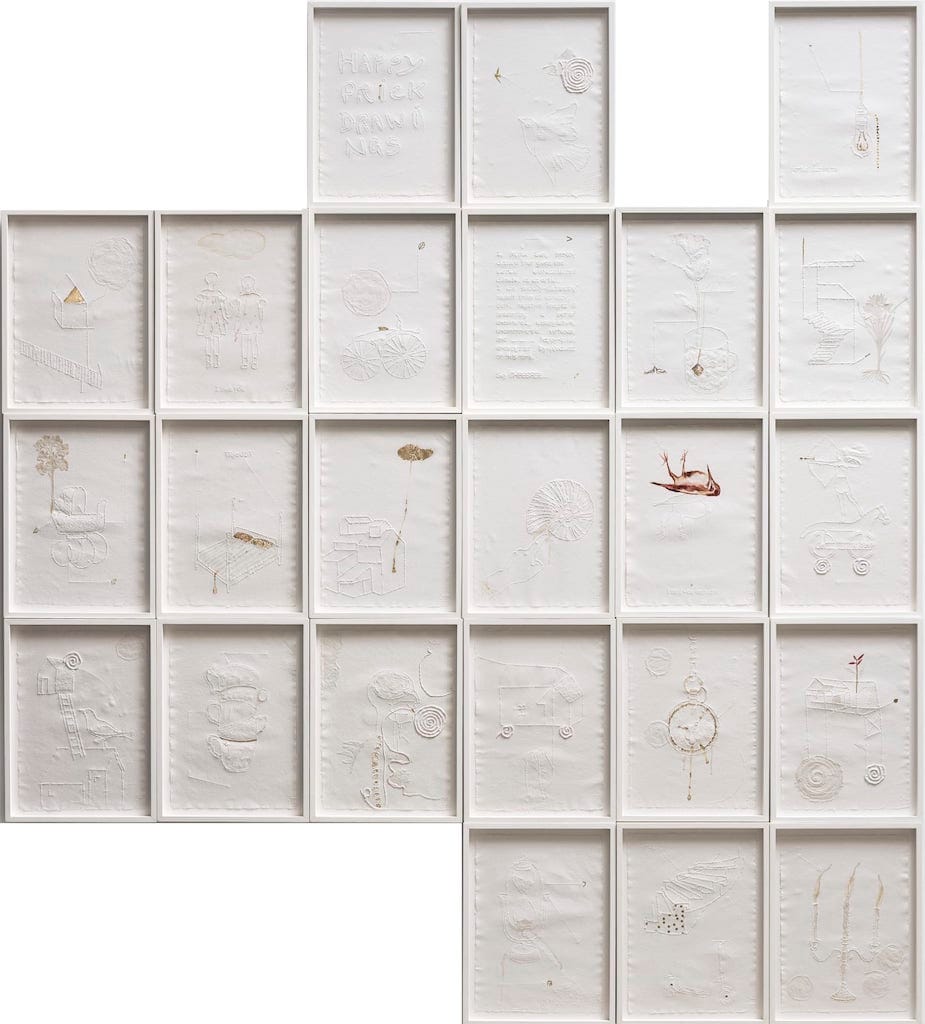
NS: Your work often challenges conventional boundaries—whether between art and language, the personal and the political, or even the expected and the unsettling. How do you navigate these tensions in your practice?
MS: My practice thrives in a state of perpetual unsettlement—a feminist, strategic resistance to fixed identities, normative systems, and institutional hierarchies. I dismantle coherence, mock mastery, and embrace slippage as a site of possibility. The work is not just about feminism—it is feminist in its form, method, and refusal to settle.
I draw from Donna Haraway’s idea of “staying with the trouble.” Rather than seeking clarity, I inhabit ambiguity and contradiction. My self-representation is fluid, fragmented, ironic, sometimes grotesque—a queering of form, a living glitch-as-witch.
I use strategic asemia and lingual anarchy—gibberish, non-verbal codes, and poetic disruptions—to resist the colonial, patriarchal authority of standardized language. This aligns with cyberfeminist critiques of algorithmic control. My misuse becomes a political refusal: a language that cannot be monetized or domesticated.
My medium is playbour—play as labour, humour as sabotage. I find joy in the trickster’s role, disrupting the circus of moral policing. Discomfort, mess, intimacy—what dominant systems dismiss as irrational or unprofessional—are reclaimed as tools of resistance.
There’s a persistent erotic mysticism in the work, echoing Audre Lorde’s idea of the erotic as power. I embrace error, illegibility, excess—not just in form, but in intent. In a world obsessed with polish and legibility, my refusal becomes an ethics of glitch.
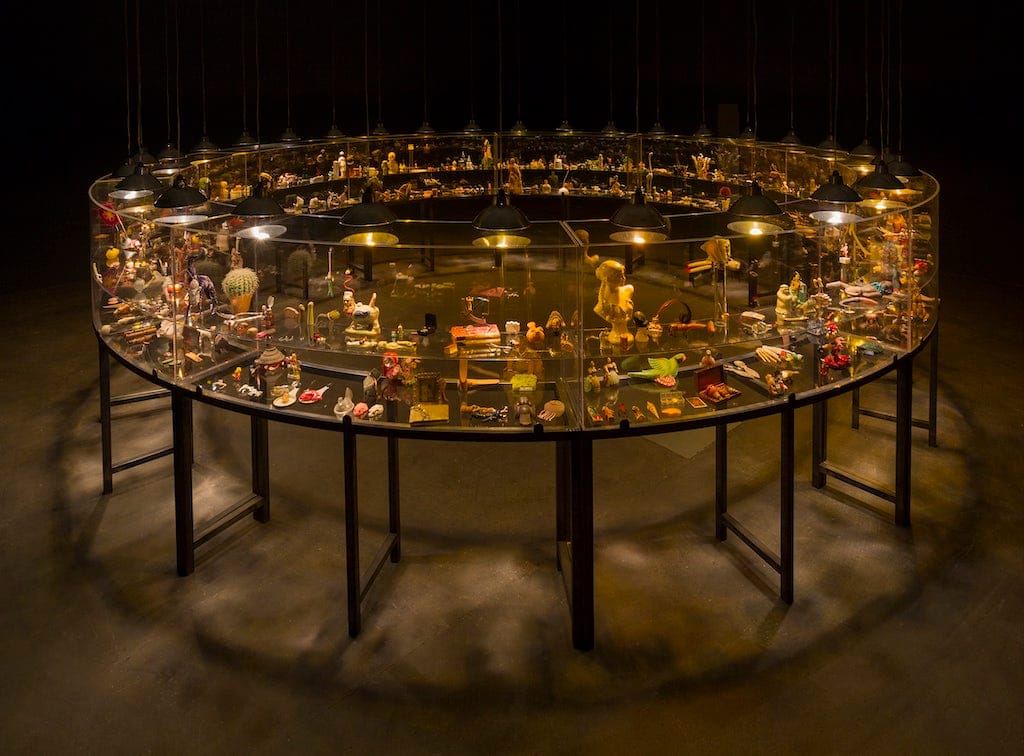

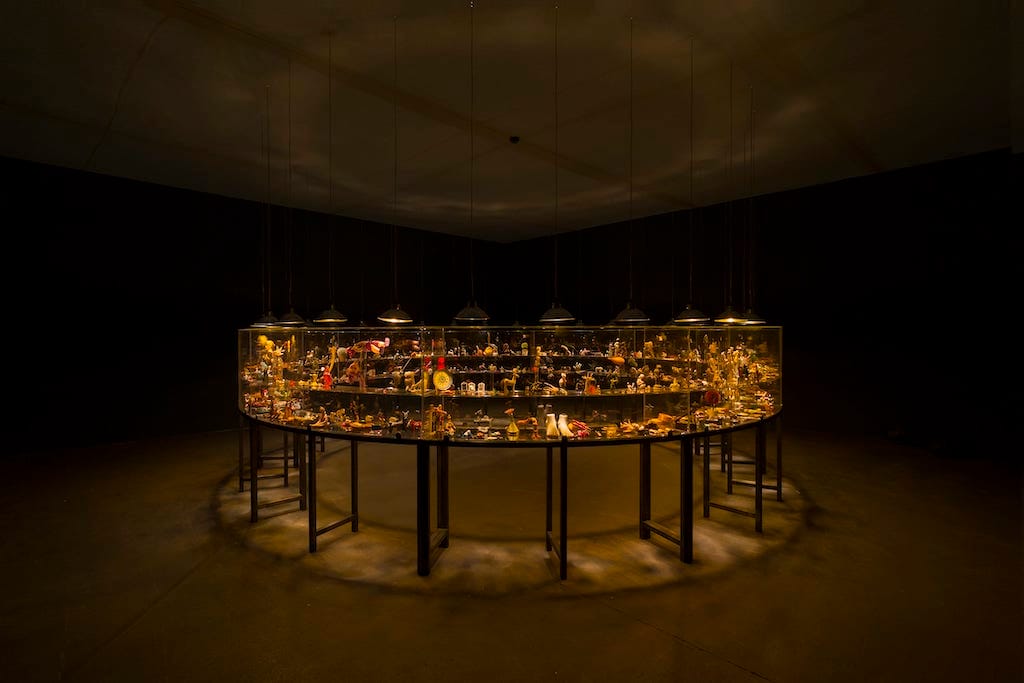
Mithu Sen, MOU (Museum of Unbelongings), 2011–2018, installation view at Art Unlimited, Basel, 2016 © Mithu Sen
NS: The concept of ‘radical hospitality’ is central to your work. Could you elaborate on what it means in the context of your artistic practice and how you translate this idea into material form?
MS: Radical hospitality begins with contradiction, play, and the unfixing of roles. It’s not about comfort, but about welcoming the unfamiliar. In my practice, this manifests through poetic contracts, artist declarations, and legal papers that question authority, unsettle meaning, and expose institutional absurdities.
Since 2017, I’ve been working with notarized declarations—starting with one that stated, “All my tangible artworks are byproducts.” These contracts are not just documents—they are performative gestures, tools for unmything the aura of art, undoing authorship, and reversing hierarchies. The “byproducts” become remnants of the process—tactile, absurd, often emotional.
These contracts challenge the cold rationality of juridical language, turning it into something utopian, interactive, even tender. They sit beside artworks like glitches—provocations that demand participation and mutuality. They are my way of asserting presence, not just as an artist, but as a thinking, feeling body navigating structures.
Through captioning, absurd instructions, and emotive labeling, I make visible the undercurrents—impulses and intuitions that usually get erased by academic rigour. I work through un-ing—unmaking norms, unlearning logic—using playbour, humour, and glitch as materials. Radical hospitality, for me, is about holding space for all of that.
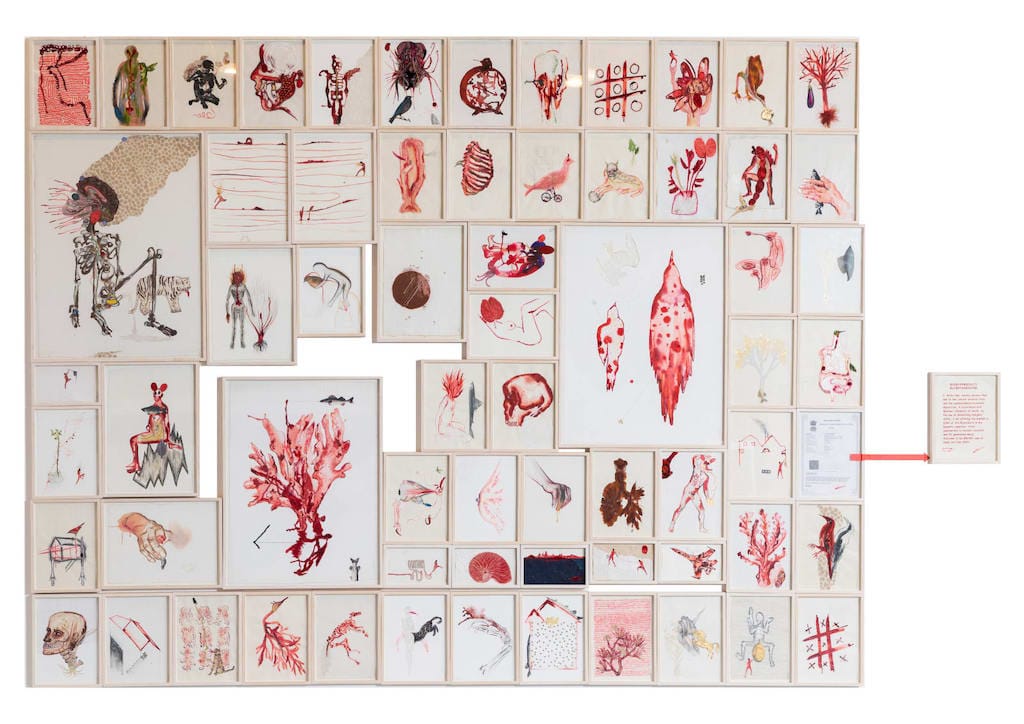
NS: Your performances and installations frequently incorporate elements of the absurd, discomfort, and unpredictability. What draws you to these themes, and how do you see them influencing the viewer’s experience?
MS: I’m drawn to the absurd, discomfort, and unpredictability because they interrupt the expected and destabilize fixed meanings—allowing something more raw, instinctual, and affective to emerge. These themes help dismantle institutional habits of viewing, making space for vulnerability, doubt, and new modes of perception.
A key example is my conceptual project Cognitive Ignorance (2020), a durational performance and exhibition staged by the fictional collective WinWin88 at the India Art Fair. It was structured across three parts—an immersive art lab, a veiled magazine interview, and a book—and was rooted in anonymity, legal fiction, and performative strategies.
By removing all artist names, captions, and didactic texts, we challenged viewers to navigate the space through sensory tools and participatory prompts, transforming the exhibition into a live, affective laboratory. The discomfort of not knowing—of being unanchored—was central to the work, as it made room for instinctual response and subjective engagement. The absurdity wasn’t a gimmick but a method to generate sincerity, to challenge ownership, and to subvert institutional hierarchies.
Ultimately, Cognitive Ignorance invited viewers into a shared vulnerability, turning absence into an act of radical hospitality and artistic reinvention.

NS: Language plays a crucial role in your work, particularly in your exploration of ‘lingual anarchy.’ How do you approach the process of deconstructing and reconfiguring language as an artistic tool?
MS: Language in my work is not just a medium—it’s a battlefield. After moving from Santiniketan to Delhi, I became acutely aware of how English, as a colonial remnant, operates as a gatekeeper in the Anglophonic art world. I engage with it strategically, often with discomfort, to reveal its exclusions and the labour it demands from those outside its privilege.
My idea of lingual anarchy emerges from this tension. I deconstruct language through erasures, silences, glitches, and invented scripts—what I call non-language or un-language. These forms are intentionally unreadable, sometimes even gibberish, designed to resist comprehension and challenge institutional expectations. By speaking in nonsense or creating asemic texts, I shift power away from the speaker as the authority and ask the viewer to respond instinctively, emotionally, or even uncomfortably.
This approach also stems from witnessing language loss across postcolonial geographies—people whose mother tongues were erased or overwritten. I’m curious about speculative, post-mythic forms of language that are cognitive, sensory, and embodied—where communication isn’t about clarity, but about presence and possibility.
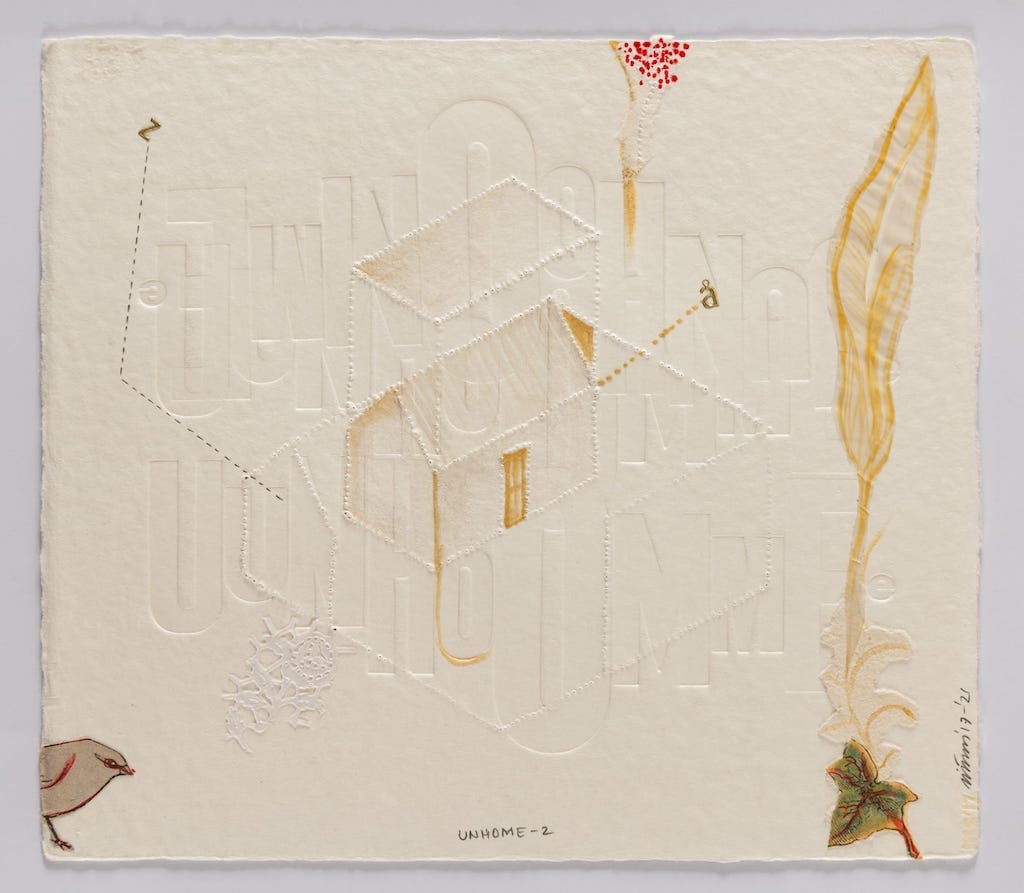
NS: Collaboration seems to be an integral part of your practice, whether through performances, exchanges, or conceptual dialogues. How do you choose your collaborators, and what do you look for in these interactions?
MS: Collaboration, for me, begins with instinct and ARTRUST—two deeply human things. I don’t choose collaborators through strategy or profile, but through a kind of intuitive resonance. It’s important that there's mutual curiosity, a willingness to be vulnerable, and space for unpredictability. I look for people who are open to risk, who don’t mind not knowing where a project might lead. That’s where the most meaningful work happens.
NS: Your work has been exhibited and performed across the world. How do different cultural contexts influence the way your art is received, and do you find that certain themes resonate differently in different spaces?
MS: It’s always an invigorating experience to see how different audiences—especially those from the Global South—engage with my work. Their responses, both as viewers and co-performers, continually shift and reshape the work’s meaning. I often use art on the network to challenge how artist identity is represented across cultures—positioning myself, at times, as a living disclaimer or anarchist provocateur. My aim is to interrogate, seduce, and destabilize fixed constructs of identity within zones of affect and experience.
In works like How to Be a SUCKcessful Artist, I critically reflect on the consumable forms of artistic persona, mapping patterns of engagement through flat, performative identities and the datafied logic of demographics. There’s a geopolitical tension—especially for female-identifying artists from the Global South—where international recognition often hinges on recycling tropes of pity, exoticism, and ‘Third World’ suffering. It’s a double-edged position, one that reveals how postcolonial narratives are entangled with the neoliberal, patriarchal, and institutional frameworks of the art world and academia.
Yet, despite these layers, what I return to is a shared humanness. Across borders and contexts, I witness audiences responding from a visceral, raw place. That emotional core is where true connection happens, and that’s the space I try to reach—beyond the gloss of identity politics or cultural exotica.
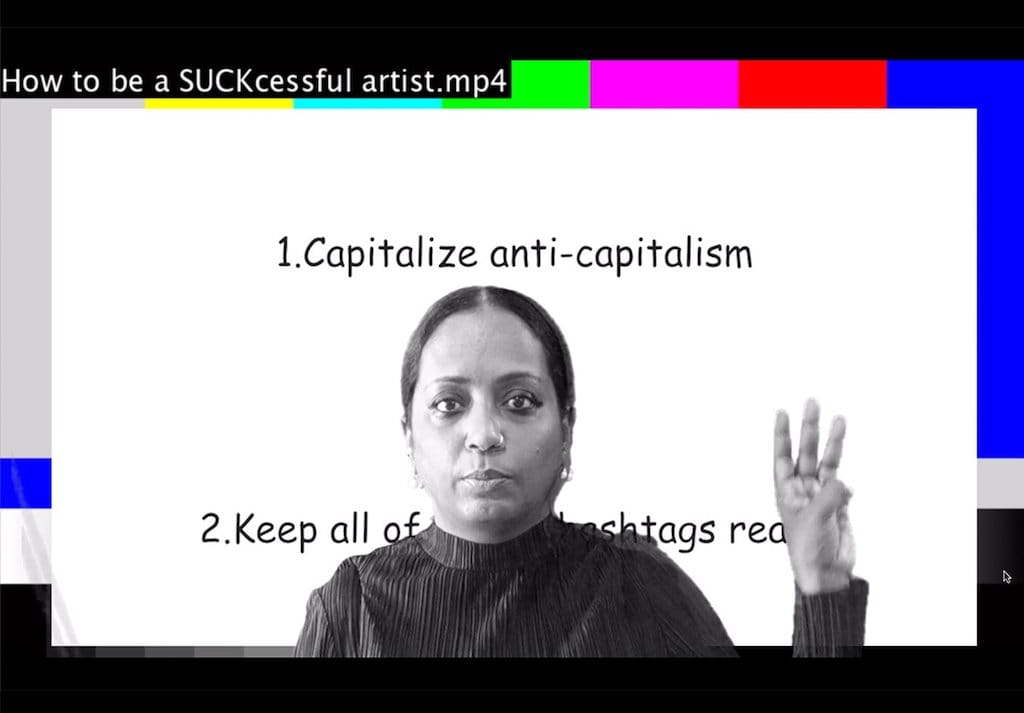
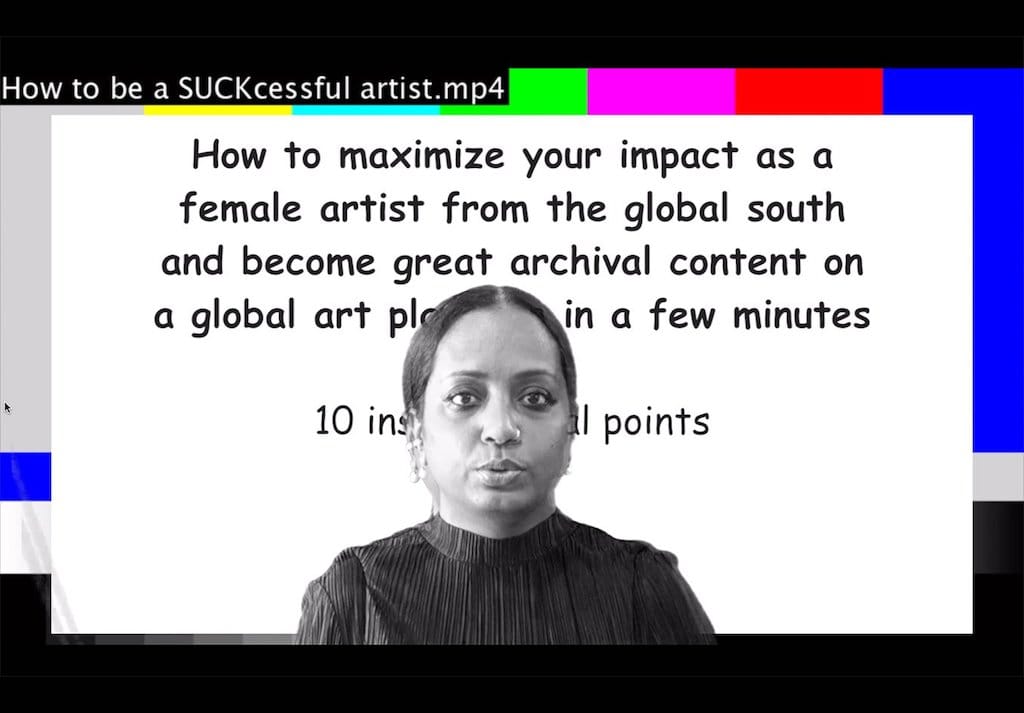
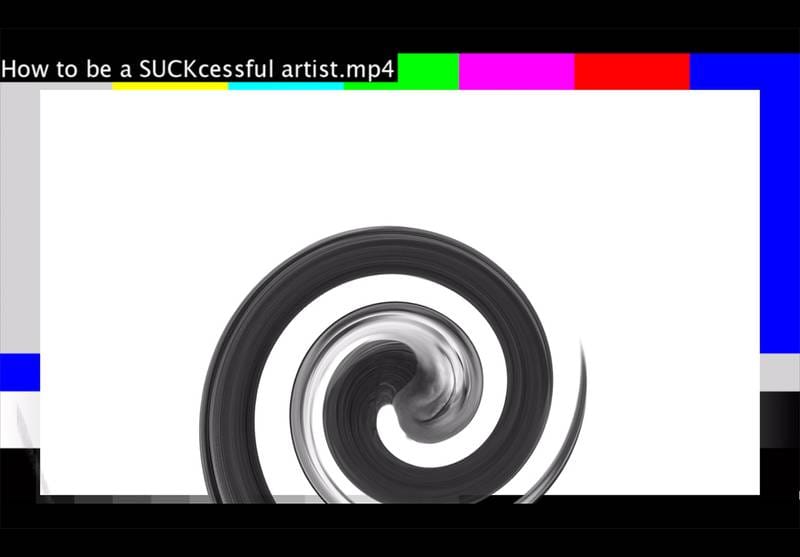
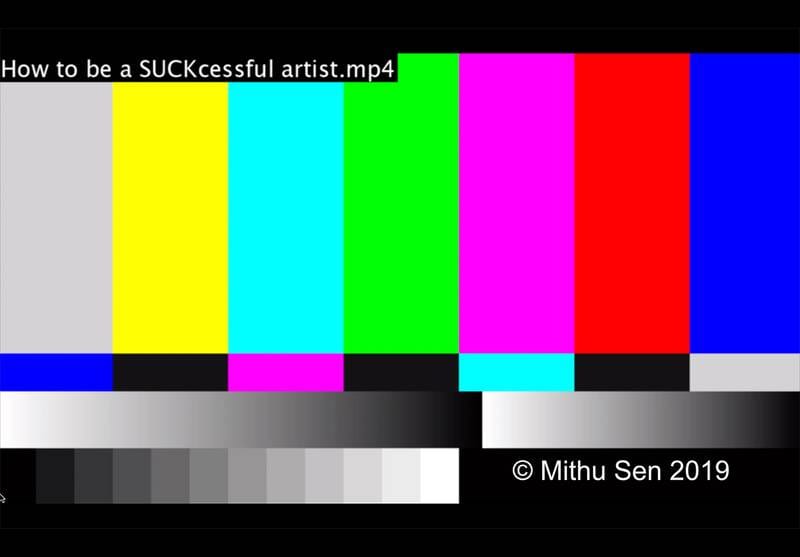
Video still from How to be a SUCKcessful Artist © Mithu Sen
UnMyth: Works and Worlds of Mithu Sen—edited by Irina Aristarkhova and published by Gallery Chemould in collaboration with Mapin Publishing—will be formally unveiled at the Kiran Nadar Museum of Art (KNMA), New Delhi, on Friday, 11 April 2025. This artist monograph presents the first comprehensive study of Mithu Sen’s wide-ranging practice, encompassing over two decades of conceptual experimentation across drawing, performance, poetry, installation, and more. Through contributions by noted scholars and curators including Sushmita Chatterjee, Karin Zitzewitz, Irina Aristarkhova, Nancy Adajania, and Max Delany, the volume delves into the critical frameworks that shape Sen’s work—mything, unmything, radical hospitality, lingual anarchy, untaboo sexuality, and unmonolith identity. With conceptual annotations by the artist and a playful fictional interview, UnMyth offers an in-depth and multilayered understanding of one of India’s most compelling contemporary artists.
